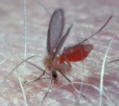
 than106.68m from their breeding area, so if they are causing a problem
one can be able to run away from them.
than106.68m from their breeding area, so if they are causing a problem
one can be able to run away from them.Commonly found at beaches, wetlands creek and lakebeds, it is believed that sand fly stays within 106.68 meters of its breeding ground.
The eggs are elongated oval-shaped, pale at first and they become dark due to exposure to air with a solitary black “eye spot”. The larvae emerge through a J-shaped fissure and don’t have legs and white like with a dark head capsule. Those of the first instar can be characterized by the presence of two caudal bristles, all subsequent instars bearing four. Fourth instar larvae also have a prominent sclerite on the dorsum of the penultimate segment. The pupae are golden brown in colour and are affixed to the surface of the substrate in which they developed by the final larval exuvium. Just before emergence the wings and eyes become black. Male sand flies emerge about 24 h before females, allowing their external genitalia time to rotate 180° to the correct position for mating before females have emerged. The time from oviposition to adult emergence at ambient temperature is around 4-6 weeks. Some Palaearctic species diapause as larvae
Cutaneous leishmaniasis (oriental sore). At the site where a sandfly has bitten, an ulcer forms. At some instances a parasite is found in the area of a wound in some species, it also infects the lymphatic system, causing skin wounds along the lymphatic ducts.
 nocturnal.
nocturnal.
Sandflies mostly breed in salt mashes; nevertheless other species breed in fresh water areas and tree holes.Larvae of sandflies are found in mud, sand and debris around the ends of the ponds, creeks springs, lakes, in tree holes or in slimy covered bark. They swim freely in water and they are normally found in twigs and leave trash. The larvae pupate on floating debris. The adult female requires blood to mature the eggs. Males do not bite.
Insecticide can be sprayed on outdoor breeding sites.
- Households are sprayed with residual insecticide on surfaces. This has
been the most effective method used . This
 controltechnique is also
used for killing
controltechnique is also
used for killing - Destroy active qualities of reservoir species. Certain species of mammals can act as important reservoirs of Leishmania By depriving life to reservoir species which live near human households, disease rates can be decreased. One can make a use of rodenticide.
- The area where the lava lives can be sprayed with an insecticide. In spite of its ineffectiveness.